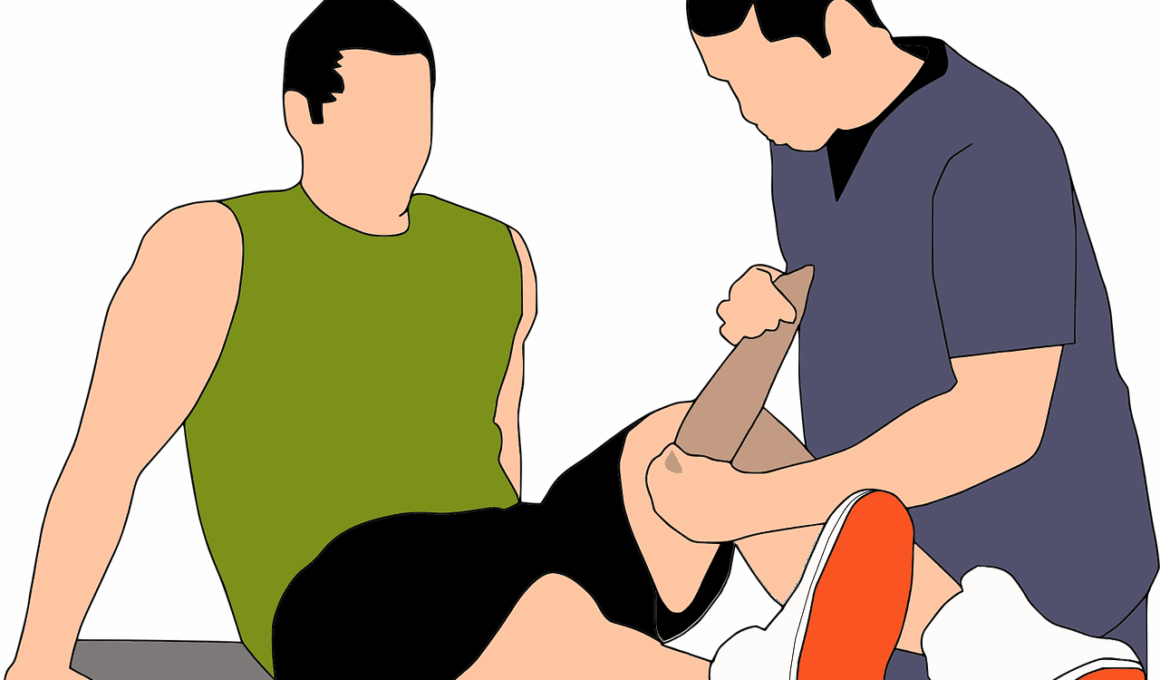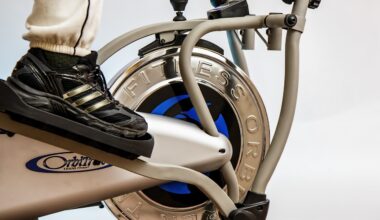The Impact of Gait Training on Sports Injury Recovery
Gait training is a rehabilitation approach focused on improving walking patterns and balance. In sports medicine, this method plays a significant role in recovery from injuries. Athletes often face lower limb injuries that can severely impact their performance and mobility. Rehabilitation through gait training helps in restoring normal patterns of movement. This process usually involves specific exercises aimed at enhancing strength, flexibility, and coordination. Clinicians often use advanced technologies like treadmills or motion analysis systems to monitor progress. The primary objective is to regain the ability to walk and run efficiently, particularly after surgical interventions. Additionally, gait training can significantly reduce the risk of future injuries by addressing any underlying biomechanical issues. Implementing a tailored gait training program not only aids recovery but also optimizes performance. Each athlete’s needs vary, and personalized plans can ensure that rehabilitation meets specific goals. As such, understanding the principles of gait training can lead to more effective rehabilitation outcomes for athletes recovering from injuries. The systematic approach also fosters athletes’ confidence, gradually reinstating their readiness for competitive activities.
Gait training techniques often consist of various drills aimed at reinforcing proper movement patterns. These drills include walking exercises, running drills, and even agility activities to promote better coordination and stability. A significant aspect of gait training is the focus on body alignment. Proper alignment ensures that the body’s weight is distributed evenly during movement, which can alleviate discomfort and promote healing. Obvious benefits of rehabilitating with gait training are increased strength in the muscles surrounding injuries. Additionally, these exercises address flexibility and endurance, improving the overall functionality of the limbs. This holistic approach motivates athletes to engage actively in their rehabilitation. The integration of feedback mechanisms, like visual and auditory cues, can enhance learning in any rehabilitation setting. Clinicians also use wearable devices to analyze walking patterns during the recovery process. These assessments guide necessary modifications in treatment to enhance recovery rates. Gait training provides a framework for athletes to reconnect with their bodies. This is crucial as they adjust mentally and physically post-injury. Therefore, it’s essential that athletes remain committed to their rehabilitation program. By doing so, they can return to their sport at maximum strength, minimising the chances of recurrence.
Enhancing Recovery Through Technology
Technology has transformed gait training, providing new avenues for rehabilitation. Motion capture systems, virtual reality, and biofeedback devices are instrumental in analyzed gait patterns accurately. These technologies allow clinicians to design personalized training programs that cater to specific rehabilitation needs. Virtual reality scenarios can create engaging environments, helping athletes simulate real-life activities. The integration of feedback accelerates learning and supports quicker recovery. For instance, a motion analysis system can pinpoint gait abnormalities and track improvements over time. Athletes receive immediate feedback on their performance, allowing them to make adjustments as needed. This continuous monitoring can significantly enhance the training process, fostering a sense of accountability. Furthermore, advancements in wearable technology empower athletes to track their daily progress outside clinical settings. By integrating everyday activities with rehabilitation goals, athletes can work more effectively towards recovery. This, in turn, enhances motivation and persistence. The technology embedded in gait training ultimately leads to a more efficient approach to injury recovery. As a result, athletes who utilize these modern techniques can experience a more dynamic recovery process, aligning rehabilitation with their performance aspirations.
In addition to technological influences, the psychological aspects of recovery play a vital role during rehabilitation. Athletes facing injuries often encounter mental barriers that can hinder their progress. Educating athletes on the importance of gait training can alleviate some fears associated with returning to action, fostering a positive outlook. Successful recovery depends not only on physical rehabilitation but also on mental readiness. Gait training facilitates this by reinforcing confidence in movement. Regular practice of gait patterns contributes to muscle memory; the skills gained during rehabilitation often translate into athletic performance. Athletes begin to trust their bodies again and re-establish their physical identity. Rehabilitation professionals can implement mental training techniques alongside physical exercises. Visualization techniques and positivity can enhance the athlete’s mindset, promoting resilience through challenges encountered during recovery. Consequently, this partnership between mental and physical training can uniquely position athletes for a swift return to their strategies. By addressing both aspects, athletes emerge from the recovery phase not only stronger physically but mentally prepared. This holistic approach establishes the groundwork for sustainable improvement, supporting long-term health and performance endurance.
Long-term Benefits of Gait Training
Gait training does not solely focus on immediate recovery but also emphasizes long-term benefits. Implementing this practice consistently contributes to enhancing overall athletic performance. Over time, athletes experience improved efficiency in their movements, allowing them to conserve energy during exertion. By strengthening the muscles involved in gait patterns, athletes become well-equipped for sustained physical activity. Enhanced functional stability during training aids in achieving optimal performance during competitions. Furthermore, consistent gait training minimizes the probability of sustaining further injuries, an essential consideration for competitive athletes. Preventing reinjury during a recovery phase allows athletes to break their previous performance barriers and reach new heights. Engaging in regular monitoring, such as periodic gait assessments, offers constructive feedback that informs training objectives over time. Thus, athletes are empowered to set new personal performance goals consistently throughout their careers. This forward-thinking approach fosters resilience, equipping them to manage future challenges. Continued participation in structured gait training is vital for athletes aspiring to prolong their careers. Ultimately, it serves as a preventative measure that enriches both rehabilitation processes and performance levels.
In conclusion, gait training stands as a pivotal part of sports injury recovery. The benefits encompass physical enhancements, technological advancements, and psychological readiness. Athletes who undergo tailored gait training programs often report quicker recoveries. This type of rehab encourages active participation and engagement in the rehabilitation process. The dynamic nature of these programs ultimately aligns physical recovery with mental readiness, laying a solid foundation for future success. As technology continues to evolve, incorporating these innovations into gait training will further enhance rehabilitation outcomes. This evolution ensures that athletes can expect timely recoveries paired with effective strategies for ongoing personal development. The result is a more complete athlete prepared to face the physical challenges of their sports with resilience. Rehabilitation specialists must continue advocating for the adoption of gait training practices. Education on its mechanisms and benefits should be emphasized to athletes engaging in recovery. By fostering a comprehensive understanding of gait training, sports departments can assure athletes are well-equipped for their competitive pursuits. Therefore, investing in gait training is a strategic approach ensuring sports professionals achieve their recovery objectives, facilitating optimal performance levels in their sporting careers.
Overall, the multifaceted aspects of gait training make it an essential tool in rehabilitation. Emphasizing proper gait can lead to more effective recovery processes. Athletes can safely return to high performance through structured programs addressing muscle imbalances and movement patterns. Understanding how the body moves ultimately equips athletes, allowing them to perform at their peak. Regular engagement in gait training can foster improved overall movement efficiency, promoting lifelong health benefits. Clinicians and athletes must work together, utilizing improved awareness of injury mechanisms and recovery strategies. Encouraging interdisciplinary collaboration between teamwork enhances rehabilitation outcomes. A comprehensive gait training program alleviates concerns and empowers athletes. As they regain their physical confidence, athletes can fully realize their potential while performing inevitably at their best.
The significance of gait training reaches diverse populations, extending beyond athletes. Individuals recovering from surgeries and conditions like stroke or arthritis also benefit from improved gait function. Developing a gradual movement pattern positively impacts quality of life for these individuals. Improvements in balance, stability, and confidence play a significant role in daily living activities. To sum up, gait training positions itself as a central theme within rehabilitation, demonstrating substantial utility across various populations. Comprehensive training aids in reducing injury risks and paves the way for a healthier lifestyle, making it a necessary aspect of preventive care and rehabilitation.


